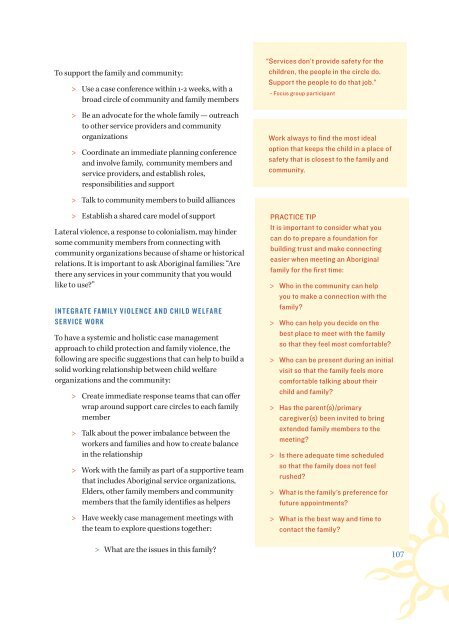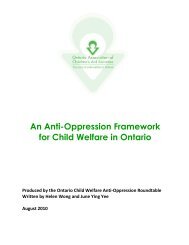English - Ontario Association of Children's Aid Societies
English - Ontario Association of Children's Aid Societies
English - Ontario Association of Children's Aid Societies
Create successful ePaper yourself
Turn your PDF publications into a flip-book with our unique Google optimized e-Paper software.
To support the family and community:<br />
> > Use a case conference within 1-2 weeks, with a<br />
broad circle <strong>of</strong> community and family members<br />
> > Be an advocate for the whole family — outreach<br />
to other service providers and community<br />
organizations<br />
> > Coordinate an immediate planning conference<br />
and involve family, community members and<br />
service providers, and establish roles,<br />
responsibilities and support<br />
> > Talk to community members to build alliances<br />
> > Establish a shared care model <strong>of</strong> support<br />
Lateral violence, a response to colonialism, may hinder<br />
some community members from connecting with<br />
community organizations because <strong>of</strong> shame or historical<br />
relations. It is important to ask Aboriginal families: “Are<br />
there any services in your community that you would<br />
like to use”<br />
INTEGRATE FAMILY VIOLENCE AND CHILD WELFARE<br />
SERVICE WORK<br />
To have a systemic and holistic case management<br />
approach to child protection and family violence, the<br />
following are specific suggestions that can help to build a<br />
solid working relationship between child welfare<br />
organizations and the community:<br />
> > Create immediate response teams that can <strong>of</strong>fer<br />
wrap around support care circles to each family<br />
member<br />
> > Talk about the power imbalance between the<br />
workers and families and how to create balance<br />
in the relationship<br />
> > Work with the family as part <strong>of</strong> a supportive team<br />
that includes Aboriginal service organizations,<br />
Elders, other family members and community<br />
members that the family identifies as helpers<br />
> > Have weekly case management meetings with<br />
the team to explore questions together:<br />
> What are the issues in this family<br />
“Services don’t provide safety for the<br />
children, the people in the circle do.<br />
Support the people to do that job.”<br />
- Focus group participant<br />
Work always to find the most ideal<br />
option that keeps the child in a place <strong>of</strong><br />
safety that is closest to the family and<br />
community.<br />
PRACTICE TIP<br />
It is important to consider what you<br />
can do to prepare a foundation for<br />
building trust and make connecting<br />
easier when meeting an Aboriginal<br />
family for the first time:<br />
> > Who in the community can help<br />
you to make a connection with the<br />
family<br />
> > Who can help you decide on the<br />
best place to meet with the family<br />
so that they feel most comfortable<br />
> > Who can be present during an initial<br />
visit so that the family feels more<br />
comfortable talking about their<br />
child and family<br />
> > Has the parent(s)/primary<br />
caregiver(s) been invited to bring<br />
extended family members to the<br />
meeting<br />
> > Is there adequate time scheduled<br />
so that the family does not feel<br />
rushed<br />
> > What is the family’s preference for<br />
future appointments<br />
> > What is the best way and time to<br />
contact the family<br />
107

















